wiper blades CHEVROLET IMPALA 2007 9.G Owners Manual
[x] Cancel search | Manufacturer: CHEVROLET, Model Year: 2007, Model line: IMPALA, Model: CHEVROLET IMPALA 2007 9.GPages: 460, PDF Size: 2.56 MB
Page 155 of 460
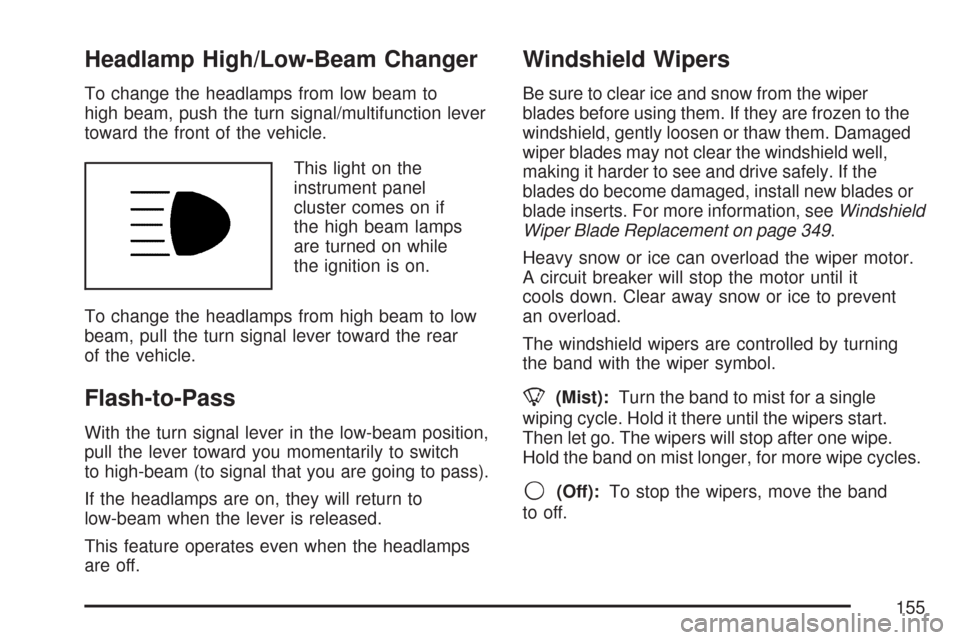
Headlamp High/Low-Beam Changer
To change the headlamps from low beam to
high beam, push the turn signal/multifunction lever
toward the front of the vehicle.
This light on the
instrument panel
cluster comes on if
the high beam lamps
are turned on while
the ignition is on.
To change the headlamps from high beam to low
beam, pull the turn signal lever toward the rear
of the vehicle.
Flash-to-Pass
With the turn signal lever in the low-beam position,
pull the lever toward you momentarily to switch
to high-beam (to signal that you are going to pass).
If the headlamps are on, they will return to
low-beam when the lever is released.
This feature operates even when the headlamps
are off.
Windshield Wipers
Be sure to clear ice and snow from the wiper
blades before using them. If they are frozen to the
windshield, gently loosen or thaw them. Damaged
wiper blades may not clear the windshield well,
making it harder to see and drive safely. If the
blades do become damaged, install new blades or
blade inserts. For more information, seeWindshield
Wiper Blade Replacement on page 349.
Heavy snow or ice can overload the wiper motor.
A circuit breaker will stop the motor until it
cools down. Clear away snow or ice to prevent
an overload.
The windshield wipers are controlled by turning
the band with the wiper symbol.
8(Mist):Turn the band to mist for a single
wiping cycle. Hold it there until the wipers start.
Then let go. The wipers will stop after one wipe.
Hold the band on mist longer, for more wipe cycles.
9(Off):To stop the wipers, move the band
to off.
155
Page 265 of 460
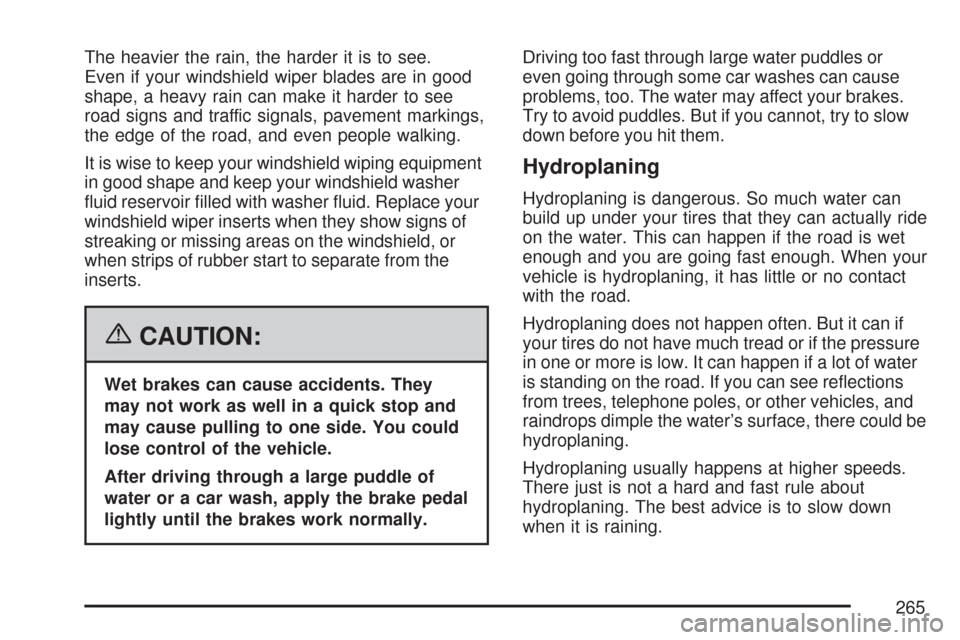
The heavier the rain, the harder it is to see.
Even if your windshield wiper blades are in good
shape, a heavy rain can make it harder to see
road signs and traffic signals, pavement markings,
the edge of the road, and even people walking.
It is wise to keep your windshield wiping equipment
in good shape and keep your windshield washer
�uid reservoir �lled with washer �uid. Replace your
windshield wiper inserts when they show signs of
streaking or missing areas on the windshield, or
when strips of rubber start to separate from the
inserts.
{CAUTION:
Wet brakes can cause accidents. They
may not work as well in a quick stop and
may cause pulling to one side. You could
lose control of the vehicle.
After driving through a large puddle of
water or a car wash, apply the brake pedal
lightly until the brakes work normally.Driving too fast through large water puddles or
even going through some car washes can cause
problems, too. The water may affect your brakes.
Try to avoid puddles. But if you cannot, try to slow
down before you hit them.
Hydroplaning
Hydroplaning is dangerous. So much water can
build up under your tires that they can actually ride
on the water. This can happen if the road is wet
enough and you are going fast enough. When your
vehicle is hydroplaning, it has little or no contact
with the road.
Hydroplaning does not happen often. But it can if
your tires do not have much tread or if the pressure
in one or more is low. It can happen if a lot of water
is standing on the road. If you can see re�ections
from trees, telephone poles, or other vehicles, and
raindrops dimple the water’s surface, there could be
hydroplaning.
Hydroplaning usually happens at higher speeds.
There just is not a hard and fast rule about
hydroplaning. The best advice is to slow down
when it is raining.
265
Page 269 of 460
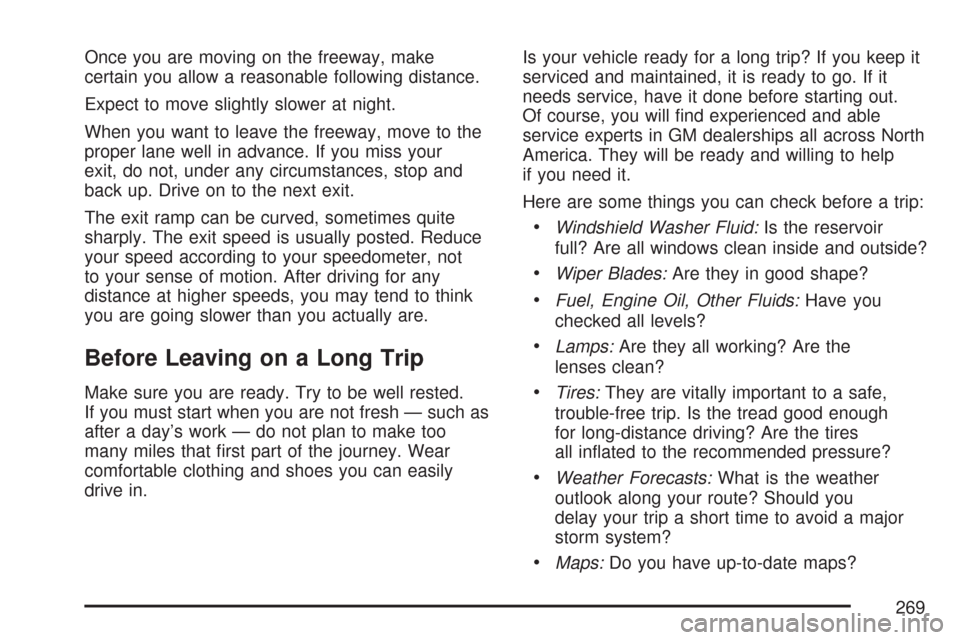
Once you are moving on the freeway, make
certain you allow a reasonable following distance.
Expect to move slightly slower at night.
When you want to leave the freeway, move to the
proper lane well in advance. If you miss your
exit, do not, under any circumstances, stop and
back up. Drive on to the next exit.
The exit ramp can be curved, sometimes quite
sharply. The exit speed is usually posted. Reduce
your speed according to your speedometer, not
to your sense of motion. After driving for any
distance at higher speeds, you may tend to think
you are going slower than you actually are.
Before Leaving on a Long Trip
Make sure you are ready. Try to be well rested.
If you must start when you are not fresh — such as
after a day’s work — do not plan to make too
many miles that �rst part of the journey. Wear
comfortable clothing and shoes you can easily
drive in.Is your vehicle ready for a long trip? If you keep it
serviced and maintained, it is ready to go. If it
needs service, have it done before starting out.
Of course, you will �nd experienced and able
service experts in GM dealerships all across North
America. They will be ready and willing to help
if you need it.
Here are some things you can check before a trip:
Windshield Washer Fluid:Is the reservoir
full? Are all windows clean inside and outside?
Wiper Blades:Are they in good shape?
Fuel, Engine Oil, Other Fluids:Have you
checked all levels?
Lamps:Are they all working? Are the
lenses clean?
Tires:They are vitally important to a safe,
trouble-free trip. Is the tread good enough
for long-distance driving? Are the tires
all in�ated to the recommended pressure?
Weather Forecasts:What is the weather
outlook along your route? Should you
delay your trip a short time to avoid a major
storm system?
Maps:Do you have up-to-date maps?
269
Page 294 of 460
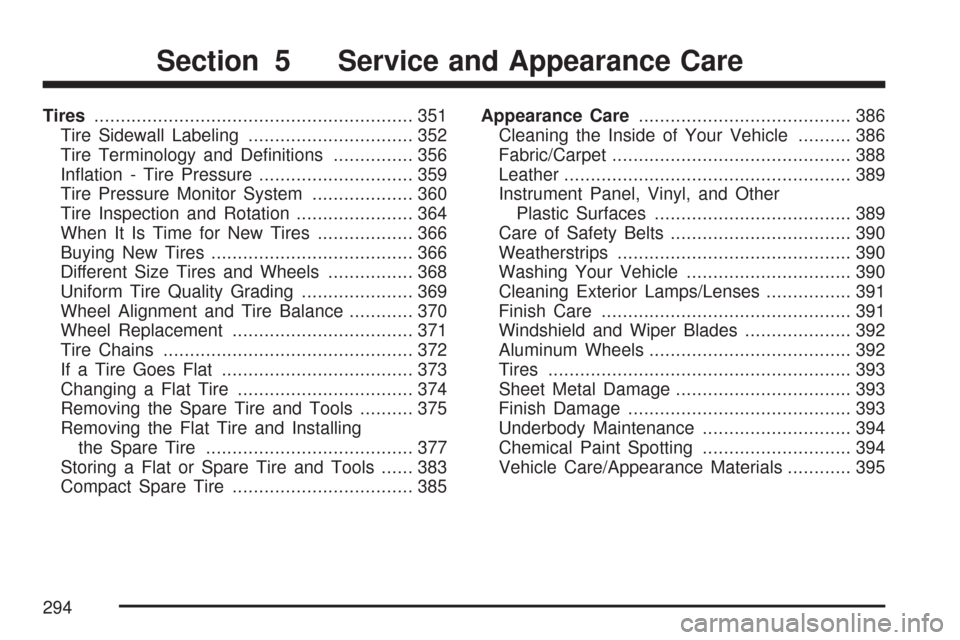
Tires............................................................ 351
Tire Sidewall Labeling............................... 352
Tire Terminology and De�nitions............... 356
In�ation - Tire Pressure............................. 359
Tire Pressure Monitor System................... 360
Tire Inspection and Rotation...................... 364
When It Is Time for New Tires.................. 366
Buying New Tires...................................... 366
Different Size Tires and Wheels................ 368
Uniform Tire Quality Grading..................... 369
Wheel Alignment and Tire Balance............ 370
Wheel Replacement.................................. 371
Tire Chains............................................... 372
If a Tire Goes Flat.................................... 373
Changing a Flat Tire................................. 374
Removing the Spare Tire and Tools.......... 375
Removing the Flat Tire and Installing
the Spare Tire....................................... 377
Storing a Flat or Spare Tire and Tools...... 383
Compact Spare Tire.................................. 385Appearance Care........................................ 386
Cleaning the Inside of Your Vehicle.......... 386
Fabric/Carpet............................................. 388
Leather...................................................... 389
Instrument Panel, Vinyl, and Other
Plastic Surfaces..................................... 389
Care of Safety Belts.................................. 390
Weatherstrips............................................ 390
Washing Your Vehicle............................... 390
Cleaning Exterior Lamps/Lenses................ 391
Finish Care............................................... 391
Windshield and Wiper Blades.................... 392
Aluminum Wheels...................................... 392
Tires......................................................... 393
Sheet Metal Damage................................. 393
Finish Damage.......................................... 393
Underbody Maintenance............................ 394
Chemical Paint Spotting............................ 394
Vehicle Care/Appearance Materials............ 395
Section 5 Service and Appearance Care
294
Page 349 of 460
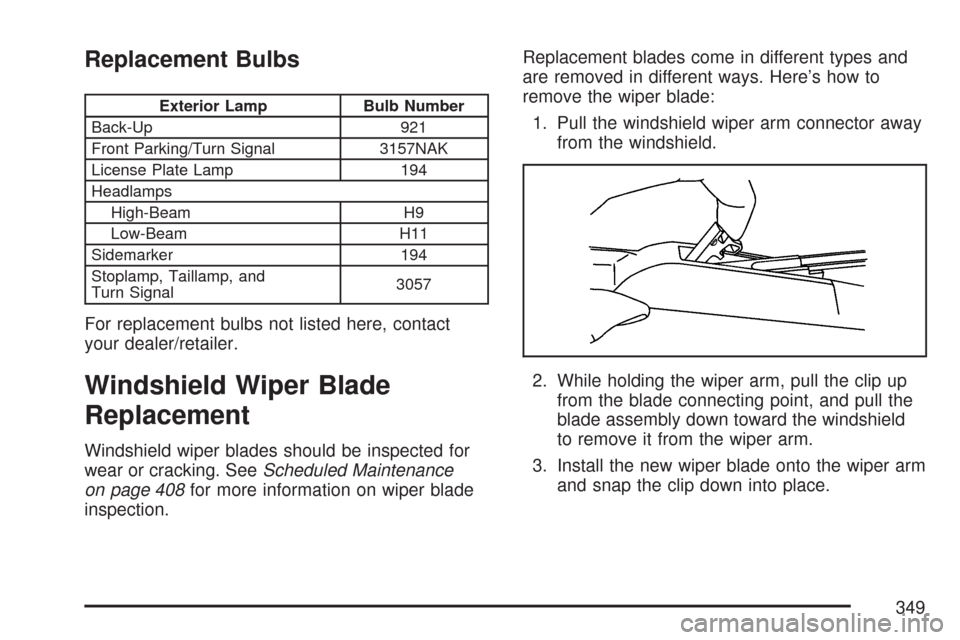
Replacement Bulbs
Exterior Lamp Bulb Number
Back-Up 921
Front Parking/Turn Signal 3157NAK
License Plate Lamp 194
Headlamps
High-Beam H9
Low-Beam H11
Sidemarker 194
Stoplamp, Taillamp, and
Turn Signal3057
For replacement bulbs not listed here, contact
your dealer/retailer.
Windshield Wiper Blade
Replacement
Windshield wiper blades should be inspected for
wear or cracking. SeeScheduled Maintenance
on page 408for more information on wiper blade
inspection.Replacement blades come in different types and
are removed in different ways. Here’s how to
remove the wiper blade:
1. Pull the windshield wiper arm connector away
from the windshield.
2. While holding the wiper arm, pull the clip up
from the blade connecting point, and pull the
blade assembly down toward the windshield
to remove it from the wiper arm.
3. Install the new wiper blade onto the wiper arm
and snap the clip down into place.
349
Page 350 of 460
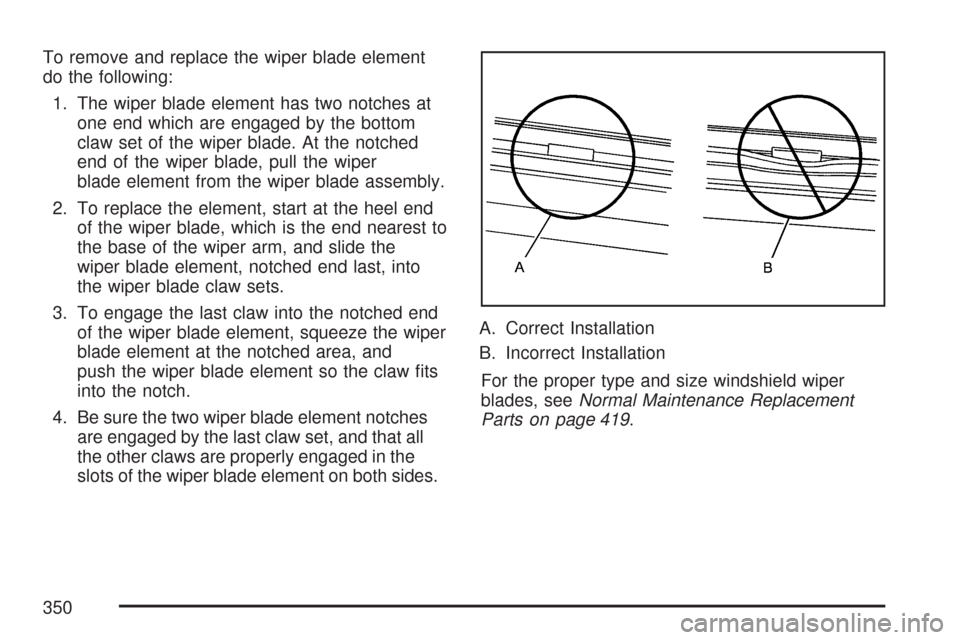
To remove and replace the wiper blade element
do the following:
1. The wiper blade element has two notches at
one end which are engaged by the bottom
claw set of the wiper blade. At the notched
end of the wiper blade, pull the wiper
blade element from the wiper blade assembly.
2. To replace the element, start at the heel end
of the wiper blade, which is the end nearest to
the base of the wiper arm, and slide the
wiper blade element, notched end last, into
the wiper blade claw sets.
3. To engage the last claw into the notched end
of the wiper blade element, squeeze the wiper
blade element at the notched area, and
push the wiper blade element so the claw �ts
into the notch.
4. Be sure the two wiper blade element notches
are engaged by the last claw set, and that all
the other claws are properly engaged in the
slots of the wiper blade element on both sides.A. Correct Installation
B. Incorrect Installation
For the proper type and size windshield wiper
blades, seeNormal Maintenance Replacement
Parts on page 419.
350
Page 392 of 460
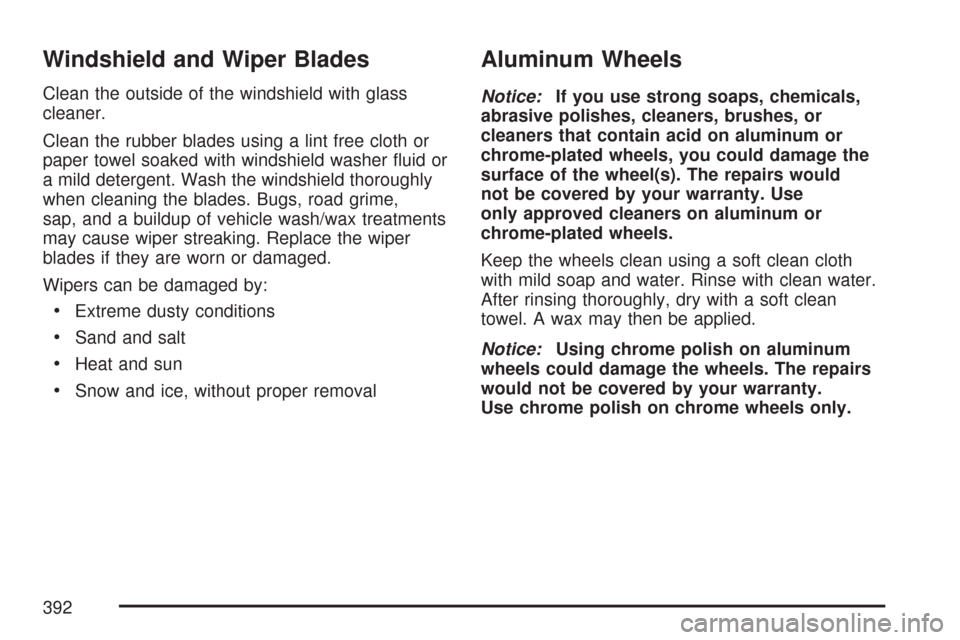
Windshield and Wiper Blades
Clean the outside of the windshield with glass
cleaner.
Clean the rubber blades using a lint free cloth or
paper towel soaked with windshield washer �uid or
a mild detergent. Wash the windshield thoroughly
when cleaning the blades. Bugs, road grime,
sap, and a buildup of vehicle wash/wax treatments
may cause wiper streaking. Replace the wiper
blades if they are worn or damaged.
Wipers can be damaged by:
Extreme dusty conditions
Sand and salt
Heat and sun
Snow and ice, without proper removal
Aluminum Wheels
Notice:If you use strong soaps, chemicals,
abrasive polishes, cleaners, brushes, or
cleaners that contain acid on aluminum or
chrome-plated wheels, you could damage the
surface of the wheel(s). The repairs would
not be covered by your warranty. Use
only approved cleaners on aluminum or
chrome-plated wheels.
Keep the wheels clean using a soft clean cloth
with mild soap and water. Rinse with clean water.
After rinsing thoroughly, dry with a soft clean
towel. A wax may then be applied.
Notice:Using chrome polish on aluminum
wheels could damage the wheels. The repairs
would not be covered by your warranty.
Use chrome polish on chrome wheels only.
392
Page 410 of 460
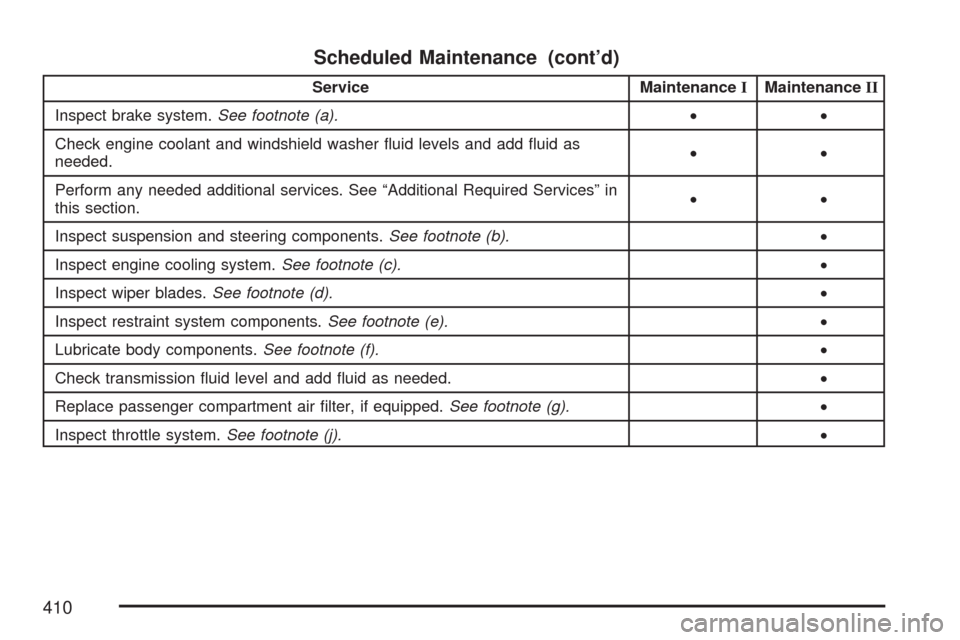
Scheduled Maintenance (cont’d)
Service MaintenanceIMaintenanceII
Inspect brake system.See footnote (a).••
Check engine coolant and windshield washer �uid levels and add �uid as
needed.••
Perform any needed additional services. See “Additional Required Services” in
this section.••
Inspect suspension and steering components.See footnote (b).•
Inspect engine cooling system.See footnote (c).•
Inspect wiper blades.See footnote (d).•
Inspect restraint system components.See footnote (e).•
Lubricate body components.See footnote (f).•
Check transmission �uid level and add �uid as needed.•
Replace passenger compartment air �lter, if equipped.See footnote (g).•
Inspect throttle system.See footnote (j).•
410
Page 412 of 460
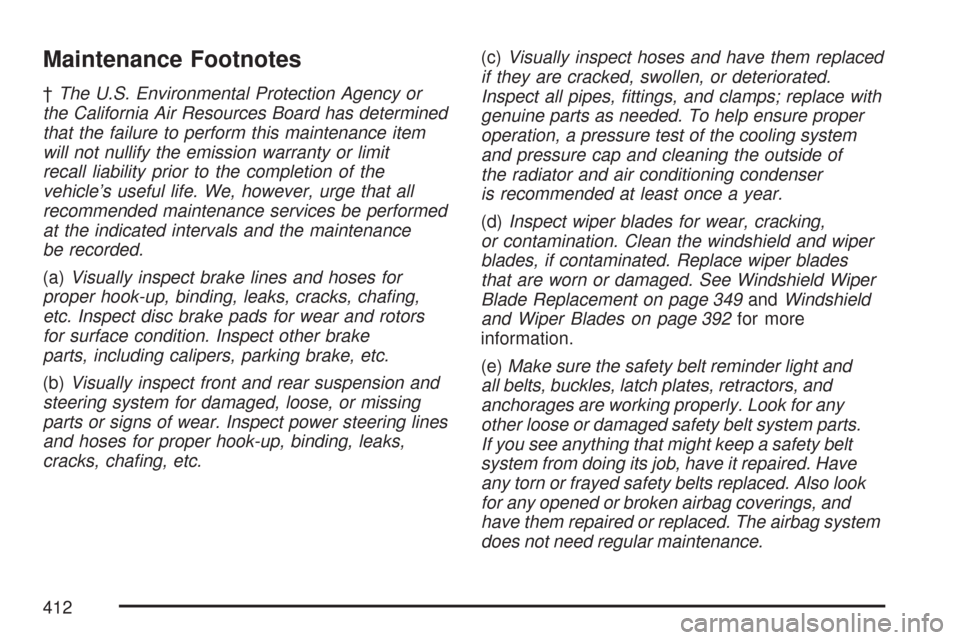
Maintenance Footnotes
†The U.S. Environmental Protection Agency or
the California Air Resources Board has determined
that the failure to perform this maintenance item
will not nullify the emission warranty or limit
recall liability prior to the completion of the
vehicle’s useful life. We, however, urge that all
recommended maintenance services be performed
at the indicated intervals and the maintenance
be recorded.
(a)Visually inspect brake lines and hoses for
proper hook-up, binding, leaks, cracks, cha�ng,
etc. Inspect disc brake pads for wear and rotors
for surface condition. Inspect other brake
parts, including calipers, parking brake, etc.
(b)Visually inspect front and rear suspension and
steering system for damaged, loose, or missing
parts or signs of wear. Inspect power steering lines
and hoses for proper hook-up, binding, leaks,
cracks, cha�ng, etc.(c)Visually inspect hoses and have them replaced
if they are cracked, swollen, or deteriorated.
Inspect all pipes, �ttings, and clamps; replace with
genuine parts as needed. To help ensure proper
operation, a pressure test of the cooling system
and pressure cap and cleaning the outside of
the radiator and air conditioning condenser
is recommended at least once a year.
(d)Inspect wiper blades for wear, cracking,
or contamination. Clean the windshield and wiper
blades, if contaminated. Replace wiper blades
that are worn or damaged. See Windshield Wiper
Blade Replacement on page 349andWindshield
and Wiper Blades on page 392for more
information.
(e)Make sure the safety belt reminder light and
all belts, buckles, latch plates, retractors, and
anchorages are working properly. Look for any
other loose or damaged safety belt system parts.
If you see anything that might keep a safety belt
system from doing its job, have it repaired. Have
any torn or frayed safety belts replaced. Also look
for any opened or broken airbag coverings, and
have them repaired or replaced. The airbag system
does not need regular maintenance.
412
Page 419 of 460
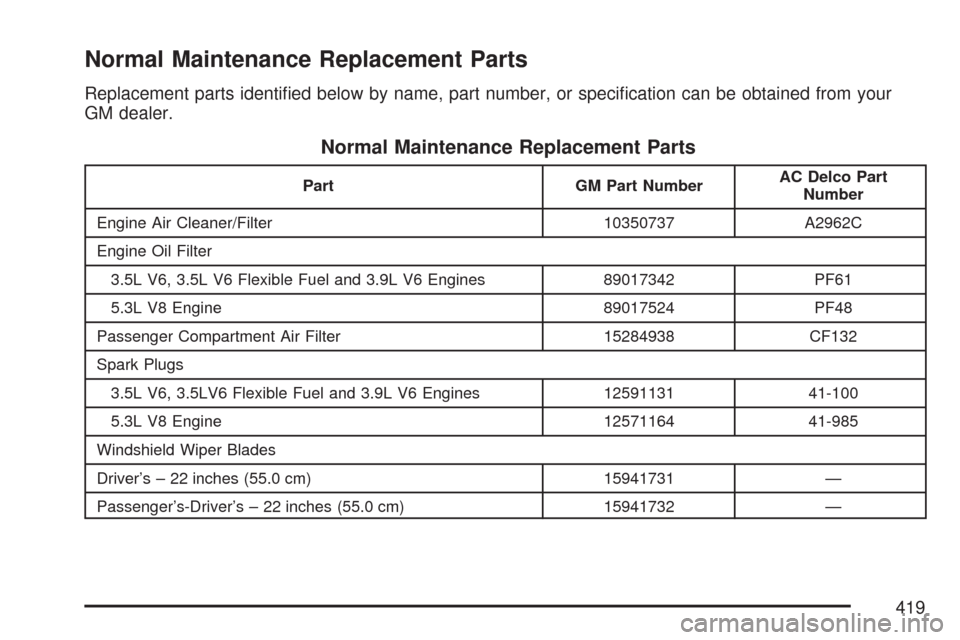
Normal Maintenance Replacement Parts
Replacement parts identi�ed below by name, part number, or speci�cation can be obtained from your
GM dealer.
Normal Maintenance Replacement Parts
Part GM Part NumberAC Delco Part
Number
Engine Air Cleaner/Filter 10350737 A2962C
Engine Oil Filter
3.5L V6, 3.5L V6 Flexible Fuel and 3.9L V6 Engines 89017342 PF61
5.3L V8 Engine 89017524 PF48
Passenger Compartment Air Filter 15284938 CF132
Spark Plugs
3.5L V6, 3.5LV6 Flexible Fuel and 3.9L V6 Engines 12591131 41-100
5.3L V8 Engine 12571164 41-985
Windshield Wiper Blades
Driver’s – 22 inches (55.0 cm) 15941731 —
Passenger’s-Driver’s – 22 inches (55.0 cm) 15941732 —
419